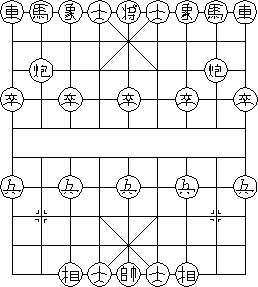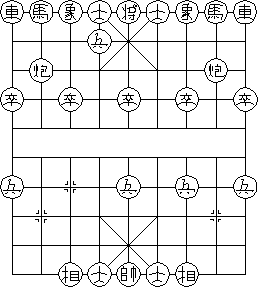5 Tigers
A Chinese Chess Variant
The latest issue of XiangQi Review contains information on a popular variant called "5 Tigers". The "5 Tigers" refers to red's 5 pawns, which have special powers. The pawns can move 2 point each move, or red could choose the option of, on one turn, moving one pawn one point, and another pawn one point. Once they cross the river, they can also move sideways, just as in standard Xiangqi. A red pawn across the river could move one point forward and one point sideways on one turn.
So how to make the game fair for black? Well, in this variant, red plays WITHOUT his 2 rooks, 2 knights, and 2 cannons! It may seem at first glance that red wouldn't have a chance with such a material deficit, but that just shows the might of the 5 tigers, as their 2-point moves can quickly overwhelm the enemy king.
This is the starting lineup:

(So, we take the standard setup of Xiangqi, and remove reds rooks, knights, and cannons.)
Red's objective is to create passed tiger-pawns and get them as close to the black king as possible to deliver mate, and also to try to take as many enemy pieces as possible. Black wants to defend his king, kill off as many tigers as possible, while remaining with enough of a material advantage to win the game. If black can exchange either a rook, knight, or cannon for each tiger, he will probably win, because he will still have one piece remaining.
To see the danger of a red tiger in the black king's palace, look at this diagram:

In this position, black is checkmated! Notice the red tiger near the black king. Because red is threatening to take his king with P6+1 and P6=5, black must either move his king or kill the tiger. He can do neither. If black's left minister were above his king, he would have the move k5=6 and could escape.
Stephen Leary
This text is written by Stephen Leary, author of the Xiangki FAQ. The figures were made by Hans Bodlaender. Thanks to Joonas Kekoni for noting an error.
WWW page created: October 24, 1995. Last modified: September 30, 1997.